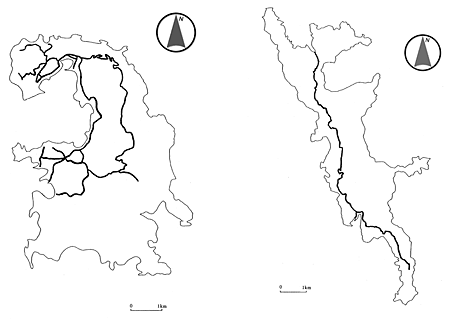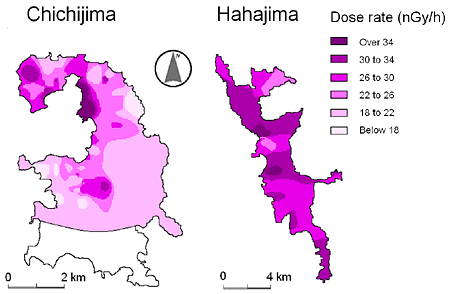1. OVERVIEW
The radiation exposure that exists in our living environment is so-called the Natural Radiation Exposure. Radioactivity from various sources exists in our environment and everyone is exposed to natural radiation without knowing in particular.
First, the earth constantly receives cosmic radiation from outer space.
One of the typical sources is the sun, and further many of the cosmic rays reach to earth from all directions. These cosmic rays also react with atmospheric gases such as nitrogen and oxygen to form secondary cosmic rays, to which we are also exposed. When we move to the higher altitude, we receive the more cosmic radiation doses because the less air loses the more shielding effect against cosmic radiation. Thus we are exposed to more radiation dose there than the sea level.
For example, at the top of Mt. Fuji, exposure to cosmic radiation is five times greater than at the sea level. If you take a round trip flight between Tokyo and New York, you will be exposed to extra radiation dose of 0.1 mSv. This amount is greater than the radiation dose receive from one piece of general chest X-ray film. The annual average effective dose per caput due to cosmic rays is 0.29 mSv in Japan, and that of world average is 0.38 mSv.
Also, humans have always been exposed to natural radiation from the earth as terrestrial radioactive sources. The granite has relatively high contamination of radioactive elements such as thorium, uranium and radium, and due to the range of granite bed, western Japan area has the more effective dose from the earth than eastern Japan.
In the world, there are geologically high terrestrial radiation areas where the radiation exposure dose is more than 5 to 10 times. For example, Ramsar in Iran, Guarapari in Brazil, Kerala in western India, and Yangjian in Guangdong Province, China, are primarily well known for the higher natural radiation dose levels. The annual worldwide average of the terrestrial radiation dose per caput is approximately 0.46 mSv, and 0.36 mSv in case of Japan.
The human body itself contains radioactive sources: potassium, lead and polonium take up the major proportion of them. The annual average per caput effective dose from radioactive components in the body such as potassium is about 0.4 mSv in Japan, and the worldwide average is 0.24 mSv.
Further, we receive the radiation dose form radon(222Rn) noble gas in the air. Radon is formed from the alpha decay of radium (222Ra) which is contained in rocks, soil, concrete, building materials, etc. The annual worldwide average dose from radon gas is 1.3 mSv, and radon contributes significantly to doses from natural radiation exposure.
The annual global average per caput effective dose due to natural radiation sources is 2.4 mSv, and about 1.5 mSv in Japan.
2. ENVIRONMENTAL RADIATION EXPOSURES IN CHICHI-JIMA AND HAHA-JIMA, OGASAWARA ISLANDS
The Ogasawara Islands consist of uplifted portions of submarine volcanoes. While the Izu Islands are composed of andesite and basaltic rocks, the Ogasawara Islands are composed of pillow lava.
Concerning environmental radiation and radioactivity in the Izu Islands and Ogasawara Islands (including islands other than the Muko-jima Group, Chichi-jima Group and Haha-jima Group), although there has been some research on Izu-Oshima and Hachijo-jima (Izu islands), no detailed studies are available for other islands. Therefore, as part of research on natural radiation exposure and radioactive materials to the environment in the islands of Tokyo Prefecture, we conducted a study on the environmental gamma-ray dose rates, natural radionuclide concentrations, and radon and thoron exhalation rates in Chichi-jima and Haha-jima in the Ogasawara Islands. This year (2008) marks the 40th anniversary of Ogasawara's return to Japanese sovereignty, and now the great interest of whole the islands, richly endowed with natural resources, look forward to receiving the inscription of World Natural Heritage.
The study was conducted from August 28 to 30, 2006, during which the environmental gamma-ray dose rates, natural radionuclides density, radon (222Rn) and thoron (220Rn) exhalation rates, and indoor radon density were measured in Chichi-jima and Haha-jima.
Measurements of the environmental gamma-ray dose rates have been done using a 2"Φ × 2" NaI(Tl) scintillator (model: S-2361-8820B, Ohyo Koken), and acquiring raw-data for every one minute consecutively while we drove along the routes shown in Fig. 1. at a speed of 30-50 km/h (around 40 km/h on average). Fig. 2. shows the dose maps for Chichi-jima and Haha-jima. The environmental gamma-ray dose rates in Chichi-jima and Haha-jima were 27.7 nGy/h and 35.4 nGy/h respectively, lower than the nation-wide average of 50 nGy/h.
 |
| Figure 1 Measurement routes in Chichijima and Hahajima |
 |
| Figure 2 Maps showing environmental gamma-ray dose rates in Chichijima and Hahajima |
Measurements of natural radionuclides densities have been done using a 2"Φ × 2" NaI(Tl) scintillator (model: S-2361-8820B, Ohyo Koken) and performing stationary measurement for 900 consecutive seconds. From the measured wave height distribution, each density of uranium series, thorium series, and potassium was calculated. We chose bare ground for measurement sites, and measured at five sites in Chichi-jima and two sites in Haha-jima (site details are shown in Table 1. The natural radionuclide concentrations were 0.88% (40K), 0.22 ppm (U), and 0.26 ppm (Th) in Chich-jima, and 0.35% (40K), 0.15 ppm (U), and 1.5 ppm (Th) in Haha-jima.
Table 1. Measurement sites in Chichij-ima and
Haha-jima for natural radiation exposures |
 |
Measurements of radon (222Rn) and thoron (220Rn) exhalation rates have been done using an in-situ type exhalation rate measuring system (MSZ) for 30 minutes. We obtained data at four sites in Chichi-jima and two sites in Haha-jima (site details are shown in Table 2. MSZ is a 30 × 40 cm scintillation survey meter with a ZnS(Ag) scintillation detector and a gas container of 13 liters capacity. MSZ can calculate the exhalation rates of radon (222Rn) and thoron (220Rn) simultaneously by multiplying the count rate obtained in the first/second half of the measurement time by a conversion factor for each substance.
Table 2. Measurement sites in Chichi-jima and Hahaj-ima
for radon and thoron exhalation rates |
 |
As shown in Table 3, the radon (222Rn) and thoron (220Rn) exhalation rates were below the minimum of the detection range (222Rn) and 85 mBq/m2/s (220Rn) in Chichi-jima, and 3.8 mBq/m2/s (222Rn) and 219 mBq/m2/s (220Rn) in Haha-jima. These values were higher than those in Miyake-jima in the Izu Islands, for which we have detailed data.1) to 4)
Table 3. Radon and thoron exhalation rates
in Chichi-jima and Haha-jima (mBq•m-2•s-1) |
 |
3. POSTSCRIPT
I was requested by the Japan Industries Association of Radiological Systems (JIRA) to write an article on environmental radiation, a topic in a different field from those usually published in the Radiology Japan.
My laboratory in the Department of Radiological Sciences, Graduate School of Human Health Sciences, Tokyo Metropolitan University, has three research themes: <1> nuclear medicine study technologies, <2> environmental radiation and radioactivity, and <3> health physics. I have introduced the research findings of this study on environmental radiation and radioactivity in the Ogasawara Islands in connection with research theme <2>, environmental radiation and radioactivity.
This article introduced a part of very low radiation fields concern with human’s environment, apparently different from diagnostic medical X-ray radiation exposures concerned with common readers of the Radiology Japan. I believe that further researches excavating through comprehensive studies on low, medium, and high radiation exposures will be increasingly important for the emerging needs of utilizations and researches on the effects of radiation exposures.
<References>
1) Masahiro HOSODA, Masahiro FUKUSHI, Masato SUGINO, Masahide FURUKAWA and Michikuni SHIMO (2006): Natural radiation on Miyakejima, Izu Islands, Japan. Japanese Journal of Health Physics, Vol. 40, pp. 365-370.
2) Masahiro FUKUSHI, Masahiro HOSODA, Michikuni SHIMO, Masahide FURUKAWA, Masato SUGINO, Kazuyuki MINAMI and Giichiro NAKATANI (2006): Distribution of natural radiation and status in Miyakejima after volcanic eruption. Safety & Health Digest, Vol. 52, pp. 10-14.
3) Masahiro HOSODA, Yusuke YAMAMOTO, Kazumasa HARADA, Toshinari KORI, Masahiro FUKUSHI and Michikuni SHIMO (2006): Effect of environmental factors on the exhalation of radon and thoron from the soil to the atmosphere. AOCRP-2, full paper, pp. 1-4.
4) Masahiro HOSODA, Michikuni SHIMO, Masato SUGINO, Masahide FURUKAWA and Masahiro FUKUSHI (2006): Relation between radon and thoron exhalation rates, the environmental gamma-ray dose rate, and natural radionuclide concentrations. Japanese Journal of Health Physics, Vol. 41, pp. 18-26.
|

